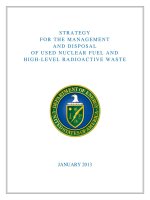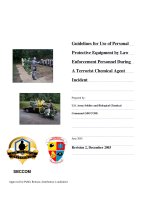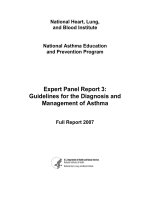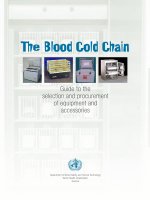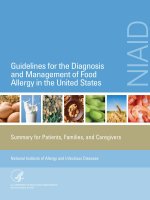Guidance for the Selection and Use of Personal Protective Equipment (PPE) in Healthcare Settings doc
Bạn đang xem bản rút gọn của tài liệu. Xem và tải ngay bản đầy đủ của tài liệu tại đây (284.75 KB, 49 trang )
1
Guidance for the Selection and
Use of Personal Protective
Equipment (PPE) in Healthcare
Settings
2
PPE Use in Healthcare Settings:
Program Goal
Improve personnel safety in the
healthcare environment through
appropriate use of PPE.
PPE Use in Healthcare Settings
The goal of this program is to improve personnel safety in the healthcare
environment through appropriate use of PPE.
3
PPE Use in Healthcare Settings:
Program Objectives
• Provide information on the selection and use
of PPE in healthcare settings
• Practice how to safely don and remove PPE
PPE Use in Healthcare Settings
The objectives of this program are to provide information on the selection and use
of PPE in healthcare settings and to allow time for participants to practice the
correct way to don and remove PPE.
4
Personal Protective Equipment
Definition
“specialized clothing or equipment worn by an
employee for protection against infectious
materials” (OSHA)
PPE Use in Healthcare Settings
Personal protective equipment, or PPE, as defined by the Occupational Safety and
Health Administration, or OSHA, is “specialized clothing or equipment, worn by an
employee for protection against infectious materials.”
5
Regulations and
Recommendations for PPE
• OSHA issues workplace health and safety
regulations. Regarding PPE, employers must:
– Provide appropriate PPE for employees
– Ensure that PPE is disposed or reusable PPE is cleaned,
laundered, repaired and stored after use
• OSHA also specifies circumstances for which PPE is
indicated
• CDC recommends when, what and how to use PPE
PPE Use in Healthcare Settings
OSHA issues regulations for workplace health and safety. These regulations require
use of PPE in healthcare settings to protect healthcare personnel from exposure to
bloodborne pathogens and Mycobacterium tuberculosis. However, under OSHA’s
General Duty Clause PPE is required for any potential infectious disease exposure.
Employers must provide their employees with appropriate PPE and ensure that PPE
is disposed or, if reusable, that it is properly cleaned or laundered, repaired and
stored after use.
The Centers for Disease Control and Prevention (CDC) issues recommendations for
when and what PPE should be used to prevent exposure to infectious diseases. This
presentation will cover those recommendations, beginning with the hierarchy of
safety and health controls.
6
Hierarchy of Safety and Health
Controls
• Training and administrative controls
• Engineering controls
• Work practice controls
• Personal protective equipment
PPE Use in Healthcare Settings
The protection of healthcare personnel from infectious disease exposures in the
workplace requires a combination of controls, one of which is the use of PPE. It is
important to recognize that your protection as a healthcare worker also involves
other prevention strategies. There are four major components to healthcare worker
safety programs. First are training, such as you’re receiving today, and
administrative controls, like isolation policies and procedures, and procedures for
recognizing patients with a communicable disease before they expose workers.
Second are engineering controls like negative pressure rooms for patients with
airborne diseases such as TB; third are work practice controls such as not recapping
needles, and finally personal protective equipment . While PPE is last in the
hierarchy of prevention, it is very important for protecting healthcare workers from
disease transmission.
7
Types of PPE Used in
Healthcare Settings
• Gloves – protect hands
• Gowns/aprons – protect skin and/or clothing
• Masks and respirators– protect mouth/nose
– Respirators – protect respiratory tract from airborne
infectious agents
• Goggles – protect eyes
• Face shields – protect face, mouth, nose, and eyes
PPE Use in Healthcare Settings
All of the PPE listed here prevent contact with the infectious agent, or body fluid
that may contain the infectious agent, by creating a barrier between the worker and
the infectious material. Gloves, protect the hands, gowns or aprons protect the skin
and/or clothing, masks and respirators protect the mouth and nose, goggles protect
the eyes, and face shields protect the entire face.
The respirator, has been designed to also protect the respiratory tract from airborne
transmission of infectious agents. We’ll discuss this in more detail later.
8
Factors Influencing PPE Selection
• Type of exposure anticipated
– Splash/spray versus touch
– Category of isolation precautions
• Durability and appropriateness for the task
• Fit
PPE Use in Healthcare Settings
When you are selecting PPE, consider three key things.
First is the type of anticipated exposure. This is determined by the type of
anticipated exposure, such as touch, splashes or sprays, or large volumes of blood or
body fluids that might penetrate the clothing. PPE selection, in particular the
combination of PPE, also is determined by the category of isolation precautions a
patient is on.
Second, and very much linked to the first, is the durability and appropriateness of
the PPE for the task. This will affect, for example, whether a gown or apron is
selected for PPE, or, if a gown is selected, whether it needs to be fluid resistant,
fluid proof, or neither.
Third is fit. (optional question) How many of you have seen someone trying to
work in PPE that is too small or large? PPE must fit the individual user, and it is up
to the employer to ensure that all PPE are available in sizes appropriate for the
workforce that must be protected.
(Segue to next slide) With this as background, let’s now discuss how to select and
use specific PPE. After that we’ll talk about which PPE is recommended for
Standard Precautions and the various Isolation Precaution categories.
9
Gloves
• Purpose – patient care, environmental
services, other
• Glove material – vinyl, latex, nitrile, other
• Sterile or nonsterile
• One or two pair
• Single use or reusable
PPE Use in Healthcare Settings
Gloves are the most common type of PPE used in healthcare settings. As you can
see here, there are several things to consider when selecting the right glove for a
specified purpose.
10
Gloves
• Purpose – patient care, environmental
services, other
• Glove material – vinyl, latex, nitrile, other
• Sterile or non-sterile
• One or two pair
• Single use or reusable
PPE Use in Healthcare Settings
Most patient care activities require the use of a single pair of nonsterile gloves made
of either latex, nitrile, or vinyl. However, because of allergy concerns, some
facilities have eliminated or limited latex products, including gloves, and now use
gloves made of nitrile or other material. Vinyl gloves are also frequently available
and work well if there is limited patient contact. However, some gloves do not
provide a snug fit on the hand, especially around the wrist, and therefore should not
be used if extensive contact is likely.
Gloves should fit the user’s hands comfortably – they should not be too loose or too
tight. They also should not tear or damage easily. Gloves are sometimes worn for
several hours and need to stand up to the task.
Who uses the other glove options? Sterile surgical gloves are worn by surgeons and
other healthcare personnel who perform invasive patient procedures. During some
surgical procedures, two pair of gloves may be worn. Environmental services
personnel often wear reusable heavy duty gloves made of latex or nitrile to work
with caustic disinfectants when cleaning environmental surfaces. However, they
sometimes use patient care gloves too.
11
Do’s and Don’ts of Glove Use
• Work from “clean to dirty”
• Limit opportunities for “touch contamination” -
protect yourself, others, and the environment
– Don’t touch your face or adjust PPE with
contaminated gloves
– Don’t touch environmental surfaces except as
necessary during patient care
PPE Use in Healthcare Settings
Gloves protect you against contact with infectious materials. However, once
contaminated, gloves can become a means for spreading infectious materials to
yourself, other patients or environmental surfaces. Therefore, the way YOU use
gloves can influence the risk of disease transmission in your healthcare setting.
These are the most important do’s and don'ts of glove use.
Work from clean to dirty. This is a basic principle of infection control. In this
instance it refers to touching clean body sites or surfaces before you touch dirty or
heavily contaminated areas.
Limit opportunities for “touch contamination” - protect yourself, others and
environmental surfaces. How many times have you seen someone adjust their
glasses, rub their nose or touch their face with gloves that have been in contact with
a patient? This is one example of “touch contamination” that can potentially expose
oneself to infectious agents. Think about environmental surfaces too and avoid
unnecessarily touching them with contaminated gloves. Surfaces such as light
switches, door and cabinet knobs can become contaminated if touched by soiled
gloves.
12
Do’s and Don’ts of Glove Use
(cont’d)
• Change gloves
– During use if torn and when heavily soiled (even
during use on the same patient)
– After use on each patient
• Discard in appropriate receptacle
– Never wash or reuse disposable gloves
PPE Use in Healthcare Settings
Change gloves as needed. If gloves become torn or heavily soiled and additional
patient care tasks must be performed, then change the gloves before starting the next
task. Always change gloves after use on each patient, and discard them in the
nearest appropriate receptacle. Patient care gloves should never be washed and
used again. Washing gloves does not necessarily make them safe for reuse; it may
not be possible to eliminate all microorganisms and washing can make the gloves
more prone to tearing or leaking.
13
Gowns or Aprons
• Purpose of use
• Material –
– Natural or man-made
– Reusable or disposable
– Resistance to fluid penetration
• Clean or sterile
PPE Use in Healthcare Settings
There are three factors that influence the selection of a gown or apron as PPE. First
is the purpose of use. Isolation gowns are generally the preferred PPE for clothing
but aprons occasionally are used where limited contamination is anticipated. If
contamination of the arms can be anticipated, a gown should be selected. Gowns
should fully cover the torso, fit comfortably over the body, and have long sleeves
that fit snuggly at the wrist.
Second are the material properties of the gown. Isolation gowns are made either of
cotton or a spun synthetic material that dictate whether they can be laundered and
reused or must be disposed. Cotton and spun synthetic isolation gowns vary in their
degree of fluid resistance, another factor that must be considered in the selection of
this garb. If fluid penetration is likely, a fluid resistant gown should be used.
The last factor concerns patient risks and whether a clean, rather than sterile gown,
can be used. Clean gowns are generally used for isolation. Sterile gowns are only
necessary for performing invasive procedures, such as inserting a central line. In
this case, a sterile gown would serve purposes of patient and healthcare worker
protection.
14
Face Protection
• Masks – protect nose and mouth
– Should fully cover nose and mouth and prevent
fluid penetration
• Goggles – protect eyes
– Should fit snuggly over and around eyes
– Personal glasses not a substitute for goggles
– Antifog feature improves clarity
PPE Use in Healthcare Settings
A combination of PPE types is available to protect all or parts of the face from
contact with potentially infectious material. The selection of facial PPE is
determined by the isolation precautions required for the patient and/or the nature of
the patient contact. This will be discussed later.
Masks should fully cover the nose and mouth and prevent fluid penetration. Masks
should fit snuggly over the nose and mouth. For this reason, masks that have a
flexible nose piece and can be secured to the head with string ties or elastic are
preferable.
Goggles provide barrier protection for the eyes; personal prescription lenses do not
provide optimal eye protection and should not be used as a substitute for goggles.
Goggles should fit snuggly over and around the eyes or personal prescription lenses.
Goggles with antifog features will help maintain clarity of vision.
15
Face Protection
• Face shields – protect face, nose, mouth, and
eyes
– Should cover forehead, extend below chin and wrap
around side of face
PPE Use in Healthcare Settings
When skin protection, in addition to mouth, nose, and eye protection, is needed or
desired, for example, when irrigating a wound or suctioning copious secretions, a
face shield can be used as a substitute to wearing a mask or goggles. The face shield
should cover the forehead, extend below the chin, and wrap around the side of the
face.
16
Respiratory Protection
• Purpose – protect from inhalation of
infectious aerosols (e.g., Mycobacterium
tuberculosis)
• PPE types for respiratory protection
– Particulate respirators
– Half- or full-face elastomeric respirators
– Powered air purifying respirators (PAPR)
PPE Use in Healthcare Settings
PPE also is used to protect healthcare workers’ from hazardous or infectious
aerosols, such as Mycobacterium tuberculosis. Respirators that filter the air before
it is inhaled should be used for respiratory protection.
The most commonly used respirators in healthcare settings are the N95, N99, or
N100 particulate respirators. The device has a sub-micron filter capable of
excluding particles that are less than 5 microns in diameter.
Respirators are approved by the CDC’s National Institute for Occupational Safety
and Health.
Like other PPE, the selection of a respirator type must consider the nature of the
exposure and risk involved. For example, N95 particulate respirators might be worn
by personnel entering the room of a patient with infectious tuberculosis. However,
if a bronchoscopy is performed on the patient, the healthcare provider might wear a
higher level of respiratory protection, such as a powered air-purifying respirator or
PAPR.
17
Elements of a Respiratory
Protection Program
• Medical evaluation
• Fit testing
• Training
• Fit checking before use
PPE Use in Healthcare Settings
Prior to your using a respirator, your employer is required to have you medically
evaluated to determine that it is safe for you to wear a respirator, to fit test you for
the appropriate respirator size and type, and to train you on how and when to use a
respirator. YOU are responsible for fit checking your respirator before use to make
sure it has a proper seal.
18
For additional information on
respirators….
•
respsars.html
• />• />PPE Use in Healthcare Settings
These websites can provide you with the most up-to-date information on respirators.
19
PPE Use in Healthcare Settings:
How to Safely Don, Use, and
Remove PPE
This next segment will address how to safely don, use, and remove PPE.
NOTE TO TRAINER: Consider having a participant demonstrate donning and
removing PPE as you go through this section.
20
Key Points About PPE
• Don before contact with the patient, generally
before entering the room
• Use carefully – don’t spread contamination
• Remove and discard carefully, either at the
doorway or immediately outside patient room;
remove respirator outside room
• Immediately perform hand hygiene
PPE Use in Healthcare Settings
There are four key points to remember about PPE use. First, don it before you have
any contact with the patient, generally before entering the room. Once you have
PPE on, use it carefully to prevent spreading contamination. When you have
completed your tasks, remove the PPE carefully and discard it in the receptacles
provided. Then immediately perform hand hygiene before going on to the next
patient.
21
Sequence* for Donning PPE
• Gown first
• Mask or respirator
• Goggles or face shield
• Gloves
*Combination of PPE will affect sequence – be practical
PPE Use in Healthcare Settings
The gown should be donned first. The mask or respirator should be put on next and
properly adjusted to fit; remember to fit check the respirator. The goggles or face
shield should be donned next and the gloves are donned last. Keep in mind, the
combination of PPE used, and therefore the sequence for donning, will be
determined by the precautions that need to be taken.
22
How to Don a Gown
• Select appropriate type and size
• Opening is in the back
• Secure at neck and waist
• If gown is too small, use two gowns
– Gown #1 ties in front
– Gown #2 ties in back
PPE Use in Healthcare Settings
To don a gown, first select the appropriate type for the task and the right size for
you. The opening of the gown should be in the back; secure the gown at the neck
and waist. If the gown is too small to fully cover your torso, use two gowns. Put on
the first gown with the opening in front and the second gown over the first with the
opening in the back.
23
How to Don a Mask
• Place over nose, mouth and chin
• Fit flexible nose piece over nose bridge
• Secure on head with ties or elastic
• Adjust to fit
PPE Use in Healthcare Settings
Some masks are fastened with ties, others with elastic. If the mask has ties, place the
mask over your mouth, nose and chin. Fit the flexible nose piece to the form of
your nose bridge; tie the upper set at the back of your head and the lower set at the
base of your neck.
If a mask has elastic head bands, separate the two bands, hold the mask in one hand
and the bands in the other. Place and hold the mask over your nose, mouth, and
chin, then stretch the bands over your head and secure them comfortably as shown;
one band on the upper back of your head, the other below the ears at the base of the
neck.
Adjust the mask to fit. Remember, you don’t want to be touching it during use so
take the few seconds needed to make sure it is secure on your head and fits snuggly
around your face so there are no gaps.
24
How to Don a Particulate
Respirator
• Select a fit tested respirator
• Place over nose, mouth and chin
• Fit flexible nose piece over nose bridge
• Secure on head with elastic
• Adjust to fit
• Perform a fit check –
– Inhale – respirator should collapse
– Exhale – check for leakage around face
PPE Use in Healthcare Settings
The technique for donning a particulate respirator, such as an N95, N99 or N100, is
similar to putting on a pre-formed mask with elastic head bands. Key differences,
however, are 1) the need to first select a respirator for which you have been fit
tested and 2) fit checking the device, as you have been instructed, before entering an
area where there may be airborne infectious disease. Be sure to follow the
manufacturer’s instructions for donning the device. In some instances, the
manufacturer’s instructions may differ slightly from this presentation.
You may also be asked to wear an elastomeric or powered air purifying respirator,
or PAPR. Guidance on how to use these devices is not included in this presentation.
You will need instruction locally to properly use these devices.
25
How to Don Eye and Face
Protection
• Position goggles over eyes
and secure to the head using
the ear pieces or headband
• Position face shield over face
and secure on brow with
headband
• Adjust to fit comfortably
PPE Use in Healthcare Settings
If eye protection is needed, either goggles or a face shield should be worn. Position
either device over the face and/or eyes and secure to head using the attached ear
pieces or head band. Adjust to fit comfortably. Goggles should feel snug but not
tight.

